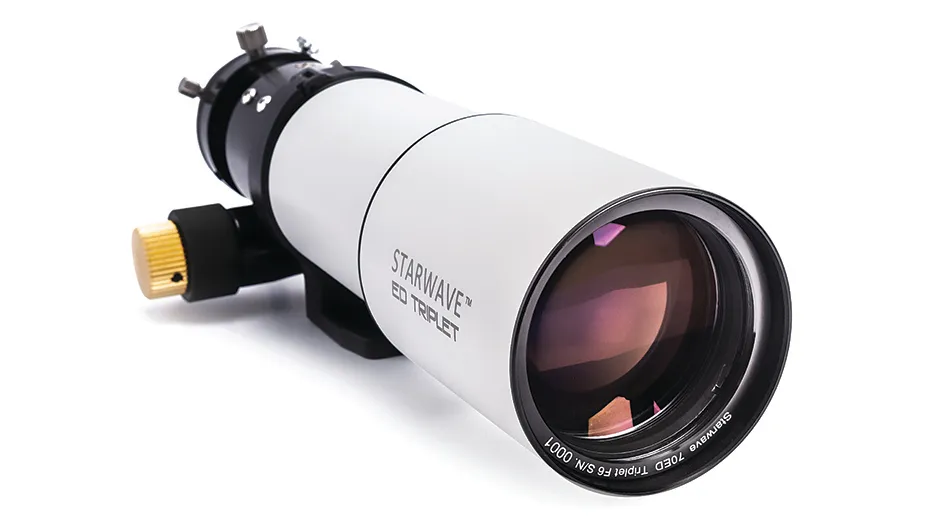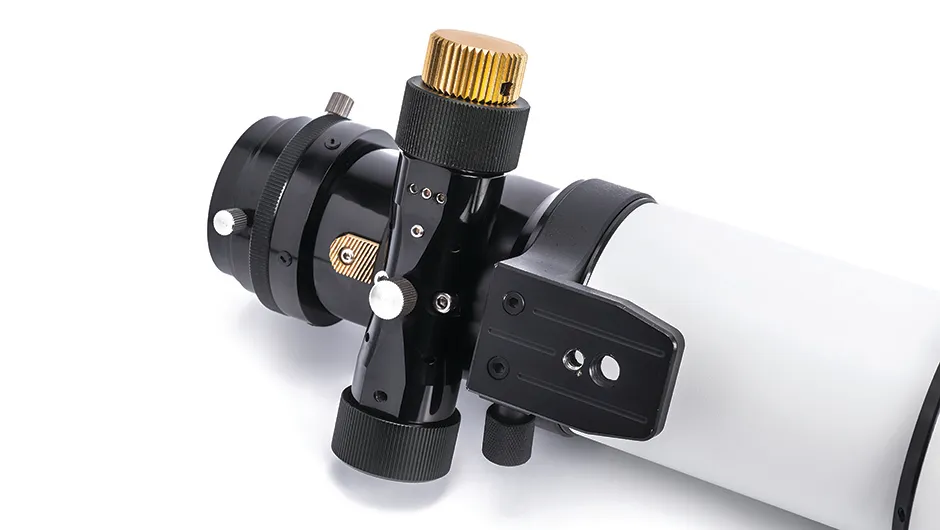For many amateur astronomers, the chance to enjoy really good dark skies only comes around when you go on holiday or attend star parties.This presents a problem, as it can be difficult or even impossible to take heavy telescopes and kit along, especially if you’re flying to your destination.With this in mind, Altair Astro has introduced a new, lightweight, travel scope: the Starwave Travel 70mm EDT-R apo refractor.
There’s a plethora of small portable refractors available, but precious few of them can provide both great views at the eyepiece and good astrophotos.
It all comes down to the design and materials used for the main lens.Here we have a 70mm apochromatic triplet.
These lenses give the best results when used with one-shot colour cameras, such as DSLRs, and the most pleasing natural colour views when used with an eyepiece because they don’t exhibit the fringing around bright objects, stars and planets.
Triplets are also great for astrophotography and there’s a 0.8x reducer available separately to match the Starwave 70mm.
We borrowed one to use with our CCD camera for some images and would recommend budgeting for the reducer if you’re considering the telescope for use with a camera.

One ring to bind them
One thing you’ll notice straight away is the single tube ring for mounting, similar to those used on photographic lenses.This caused some concern at first, especially with expensive camera equipment relying on this single point of support, but we attached a dovetail bar and the single ring easily held everything in place.
This form of mounting makes the telescope easy to use on a standard tripod or a portable mount.Under clear skies, the first thing we tested was the colour correction of the lens, which is the prime reason for choosing this type of telescope.
With the reducer in place, we photographed stars in the centre and at all four corners of the image, checking for shifts in focus in red, green and blue wavelengths.
We saw only minor differences, indicating good colour correction across the image.Without the reducer, the edges of the image are affected slightly by the curve of the lens, but views in the centre of the field are very good.Photos of a bright Moon showed no discernible colour fringing.

As an imaging instrument, the scope plus reducer proved very capable and the wide field of view offered makes it ideal for photographing extended deep-sky objects, such as the Pleiades cluster in Taurus or Rosette Nebula in Monoceros.
The dual-speed rack and pinion focuser could be smoother, especially on colder nights when freezing temperatures seemed to affect the action.But once focused and locked in place, it was able to hold our equipment firmly.The built-in rotator made it easy to frame the picture.
When clear skies gave way to cloud, we replaced the camera with our diagonal and eyepiece.
Zipping around the night sky is easy with a small refractor, and we enjoyed good, well contrasted views with a 10mm eyepiece and Barlow lens, enabling us to view faint objects including the Crab Nebula in Cancer, galaxy pair M81 and M82 in Ursa Major, and the extended nebulosity around the Orion Nebula.
Large star clusters like the Beehive Cluster in Cancer really came to life. It was a pleasure to observe Jupiter and its moons with surrounding stars, all without annoying colour aberrations spoiling the view. The Moon too was sharp and halo free.
Sheer ease of use made this scope a pleasure to observe and image with. It’s easy to see how it could become a must-have companion for holidays and star parties, or just to observe or photograph special events without the hassle of transporting and setting up heavier equipment.
FPL53 Triplet Objective
The objective lens used in the Starwave 70mm is made with Schott and Ohara FPL53 glass elements.
Highly regarded for its superior results, FPL53 glass allows optical designs that virtually eliminate the problem of chromatic aberration (CA), which can spoil an image by preventing all wavelengths or colours of light coming to focus together.
Bloated stars with coloured haloes are the usual result.
An optical design producing sharp, CA-free images across the whole field is the ultimate goal for telescopes and presents a real challenge, especially as the lens and the cell that holds it has to perform well in a wide range of temperatures.
Ohara glass is comparatively expensive and triplet-design telescopes often cost considerably more than other refractors of the same aperture, but the rewards of the improved images and views can be well worth the extra pennies.
Used with a camera, the Starwave Travel 70mm offers good colour correction and, with an eyepiece, sharp, natural-looking stars, and CA-free lunar and planetary views.

Lockable dew shield
A welcome touch for astrophotographers is the addition of three Allen grub screws on the extendable dew shield.As well as keeping out stray light and helping to reduce dew problems, it’s reassuring to know that the shield won’t slip down during use.Thumbscrews would have been easier to use when out and about.
Single Shoe mounting
Departing from the standard of twin tube rings, this single mounting shoe and ring lets you attach the telescope to a camera tripod or travel mount.For mounts, you’ll need to attach this to a short dovetail bar (sold separately).
Camera/Eyepiece Rotator
This handy feature on the focuser makes it easy to rotate the eyepiece to an accurate and comfortable position, or to help to you achieve nicely composed pictures by finding the most sympathetic way to frame of your target.
Dual-Speed Rack and Pinion Focuser
A precise focuser is vital for the best views, especially when using an unforgiving camera.The fine-tune wheel makes it easier to get accurate focus and the locking nut holds it steady without altering the focus or pushing the camera out of alignment.
Lightweight compact tube
Weighing just under 1.8kg and being only 33cm in length with the dew shield retracted, this scope is perfect for trips and is supplied with a soft travel case.Easy and quick to set up, it’s ideal for astronomy on the go.
Vital stats
- Price £599.00
- Aperture70mm (3 inches)
- FocalLength420mm (f/6)
- Weight1.8kg
- SupplierAltair Astro
- Telephone01263 731505
- www.altairastro.com
This review originally appeared in the April 2016 issue of BBC Sky at Night Magazine.

